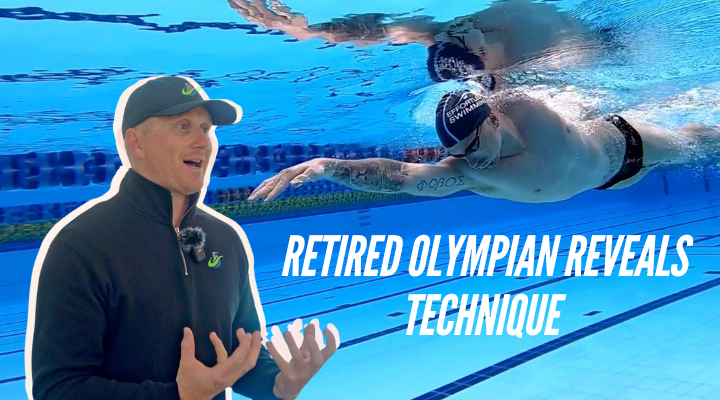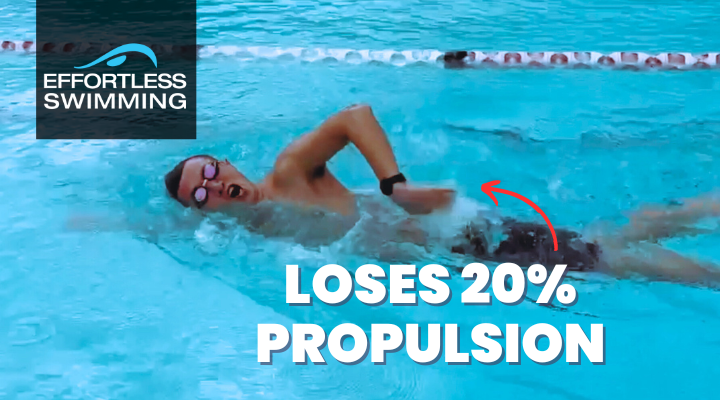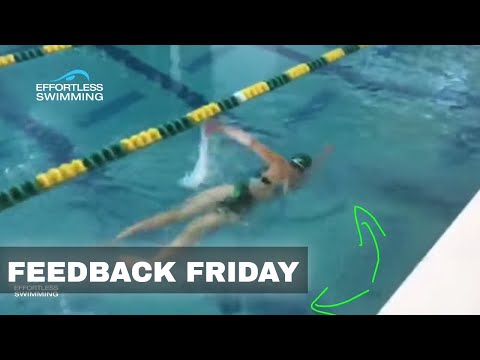This swimmer can work on:
– Keeping the head centered when he breathes (it moves off to the side)
– Narrower kick on his breathing stroke
– Keep the lead hand in motion and avoid a complete stop of the right hand. Doggy Scoop drill is good for this.
– Less reach on his right side (over-reaching)
Transcription:
And that means that you always want to keep that hand out in front in motion, so the lead hand in motion.
Welcome to Feedback Friday. In today’s episode, we have a swimmer, who sent his video in. Now, in this 50 here, it looks like he’s working pretty hard, swimming around 37 to 38 seconds for this 50, which is around the 115 to 116 pace, which is really good. At that more sprint effort, swimming around that pace, there’s a lot that you’re doing well in the stroke. Let’s have a look and see, what can we find that’s going to help this swimmer be able to hold that over longer distances and to be able to increase the speed from there.
From above, you can see the body position’s looking good. He’s sitting up well, we’ve got the head, hips, and heels at the surface. The first and probably one of the key things that I’d be looking to adjust here would be the breathing and what happens when he turns the head to breathe. So, the head is in a good position when he’s not breathing. You can say the crown of the head is above the water, just, seems to be looking slightly forwards there. That all looks good. As he turns his head to the side, notice how the head seems to shift off-center a bit. So, we’ve got this nice straight line of the spine, and then the head comes off-center there. What that causes is a little bit of extra drag because the head moves off to the side there. So, we’re getting a bit more drag created when he turns to breathe.
It can also cause a little bit of a sort of snaking movement through the hips there. It’s a little bit hard to see without that top view, but we might be getting a little bit of snaking. But the other thing that’s probably going on there is it’s probably causing his shoulders just to over-rotate a little bit, which will cause this arm to… it makes it a lot more difficult to have a good catch, an effective catch on that right hand side. So, he may be over-rotating through the shoulders. And the other thing that’s common is the legs can often splay quite wide, and it’s easy to see in this position right here. You’ll see on some of these breathing strokes that the legs are kicking a bit far apart on those breathing strikes. So, from a drag perspective, that’s a bit like opening that parachute out behind.
It’s a good thing to see, because when you see something like that, then you think, well, if he can keep his head a little bit more centered when he turns to breathe, so it’s not shifting off to the side, and if he can keep his kick narrower, keep his kick a little bit smaller so it’s basically within the line of his body, maybe coming out a little bit wider than it, but in the line of his body, that is money for jam. That means that you don’t need to put in any extra effort for a faster pace. It just means adjusting, tweaking a few little things there that can really help you increase your speed. Even if it’s one second per hundred, two seconds per hundred, that will add up over time. And if you think of how much drag that actually is when the legs kick that wide, it’s a lot.
I mean, if you’ve ever kicked with a kick board but you’ve held it against the water so the flat side is basically facing in front of you, so you’ve put it in that the harder position, that’s not a whole lot of surface area, but you’d notice how much harder it is to move through the water. That’s pretty close to how much surface area is being sort of opened up here or exposed to that oncoming water. That would be the first thing I’d be looking to do if I was this athlete, is adjust the breathing, keep the kick a little bit narrower.
Now, how could he adjust that breathing? Well, you may have seen in one of our recent episodes, we talked about doing either the side kicking drill or the FKB, front kick breathe drill. You could do that drill and focus purely on just keeping the head centered. Now, the way it should be, imagine you’ve got this skewer that runs through your spine and through your neck, and the head is on that skewer, and when it turns to breathe, it doesn’t come off that skewer. At the moment, you can see it’s come off that skewer. That’s your skewer, and his head has shifted off it. But we want to keep it in line with it. So, those two drills can be really good at yeah, at fixing that.
In terms of the kick, he may just need to feel like he’s keeping the legs very, very narrow or the kick very small when he turns to breathe. I’ve worked with swimmers, for example, we had a swimmer at our Hawaii camp last year, and she was kicking too wide in that same position in a stroke. And when we got it to stay within the line of her body, it felt like she wasn’t kicking outwards at all. She felt like the feet were together, and it’s often the exaggeration that you need in order to change some of these aspects of the stroke there. So, that’s the first thing.
The other thing you’ll see here is with the timing of the stroke, there’s just a little bit too much of a catch up on the one side. So, his right arm stays out the front a bit too long. As this hand is entering, this hand is just starting to pull, and it means that the right arm is pausing for a bit too long. So, as we come in here, we’ll see it. Yeah. It’s just not moving for… count how long it is. It comes in there and then it’s, okay, 49.2, and then it starts moving about now. It’s 49.6. So, for 0.3 to 0.4 of a second, this handout in front isn’t moving. It’s just stopping there. That deceleration means that you slow down, and it’s going to take that little bit more effort to get going again. We want to keep that momentum and that rhythm going in the stroke, and that means that you always want to keep that hand out in front in motion, so the lead hand in motion.
Now, it doesn’t mean that he should come in and pull straight through. We still want to get that nice bit of reach forwards, somewhat glide or travel on that arm out in front, but the hands should still stay in motion. We don’t want it to stop and pause completely, and it’s just stopping and pausing for a little bit too long out in front, not on every strike, but for most of them spending a little bit too long there, and so we will be slowing down and losing some of that momentum. So, what could this swimmer do to to keep that lead hand in motion? A drill I really like for this is the doggy scoop drill. That can be a good one for practicing always keeping that hand in motion because in that draw you, you won’t stop the hand from moving and it practices a good catch, it practices that reach, reach and catch motion. So, a doggy scoop drill can be very good for that.
But I think by changing the breathing, by not shifting your head off to the side, by making sure that he’s not over-rotating there, all of that stuff will help keep that moving through. That’s what I’d look to adjust there. Now, the other thing that he may need to do there on that right-hand side is change the way he’s entering the water. You’ll see that he’s got this nice recovery, so elbow led recovery, which means the elbow is leading the way for the first half. This looks good. Hand is relaxed, excellent. Comes through, still going really well, then he just overreaches a bit, and what I mean by that is he’s coming through and the elbow kind of lands first. It lands almost before the wrist or the fingertips there.
So, what he might be best off doing is as he comes over, we want to see the elbow slightly up, the fingers going in first, so the fingers should be entering the water first. That will give him a little bit of room to then slide the hand forwards under the water there instead of landing almost flat or at full extension, because there you’re just going to be pressing down on the water, and it’s pretty common to see that hand just sort of hang around a bit too long when that happens. You can see on this left hand side that’s better. He’s just going fingertips first. But that’s all you need, just going fingertips first there, that’s better. So, on the right hand side, he may just want to get that hand entry a little bit earlier so he can then slide the hand forwards under the water, which can help him keep that lead hand in motion and then keep it moving through.
And how can he change that? Well, he’s really just got to make it feel like he’s entering a fair bit earlier than what he’s used to doing there. That’s probably going to be the thing he has to change. Now, without the front view, we do have an underwater front view here. Let’s just see if we can get a sense of his alignment because sometimes we want to look at is this swimmer crossing the center when he enters because often the head shifts off to the side when you go to breathe, then it’s common for this hand to be coming across and shifting that head off to the side. It looks pretty good from here, from this angle that we can see, so I don’t think he needs to change his alignment too much there. But in terms of the catch, there’s a lot he’s doing very well there.
What you can see here, because we’ve got this underwater shot, this swimmer may need to reduce how much he’s reaching forwards with that arm. So, if we find that this hand is sort of pausing for a bit too long and the arms staying sort of straight out here for too long, sometimes it can mean that you might be overreaching with it. So, if he’s just trying to reach out for as long as he possibly can, or lengthen much as he possibly can, he’ll be better off just keeping that arm a little bit shorter. So, don’t go to full extension, just keep it a little bit shorter, and that will help him start that catch motion a little bit sooner. So, you want to be long when you swim, you want to keep that reach, that extension, but we don’t want to do it to our full extension because that can often lock the elbow out and kind of have it feel like it’s a little bit stuck, which might be happening here, so we just want to check in with that.
But you can see with this underwater shot, he’s potentially rotating a little bit far, which you can see there, 60 degrees. So, if he’s around 60 degrees, it’s outside of that 35 to 45-degree range we often want to stick to. That’s why I’d look to just reduce that shoulder rotation a little bit, and that could help him there. So, thanks for watching. If you did enjoy the video, please like it. Comment below, is there anything else that you could see in this video that this swimmer could adjust? And if you haven’t yet, just subscribe to the channel and I’ll be back next week with another video.









